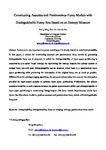Constructing accurate and parsimonious fuzzy models with distinguishable fuzzy sets based on an entropy measure
| dc.contributor.author | Zhou, Shang-Ming | |
| dc.contributor.author | Gan, JQ | |
| dc.date.accessioned | 2023-02-15T13:49:53Z | |
| dc.date.available | 2023-02-15T13:49:53Z | |
| dc.date.issued | 2006-04 | |
| dc.identifier.issn | 0165-0114 | |
| dc.identifier.issn | 1872-6801 | |
| dc.identifier.uri | http://hdl.handle.net/10026.1/20378 | |
| dc.description.abstract |
Parsimony is very important in system modeling as it is closely related to model interpretability. In this paper, a scheme for constructing accurate and parsimonious fuzzy models by generating distinguishable fuzzy sets is proposed, in which the distinguishability of input space partitioning is measured by a so-called "local" entropy. By maximizing this entropy measure the optimal number of merged fuzzy sets with good distinguishability can be obtained, which leads to a parsimonious input space partitioning while preserving the information of the original fuzzy sets as much as possible. Different from the existing merging algorithms, the proposed scheme takes into account the information provided by input-output samples to optimize input space partitioning. Furthermore, this scheme possesses the ability to seek a balance between the global approximation ability and distinguishability of input space partitioning in constructing Takagi-Sugeno (TS) fuzzy models. Experimental results have shown that this scheme is able to produce accurate and parsimonious fuzzy models with distinguishable fuzzy sets. © 2005 Elsevier B.V. All rights reserved. | |
| dc.format.extent | 1057-1074 | |
| dc.language | en | |
| dc.language.iso | en | |
| dc.publisher | Elsevier BV | |
| dc.subject | interpretability | |
| dc.subject | distinguishability | |
| dc.subject | fuzzy set merging | |
| dc.subject | entropy | |
| dc.subject | parsimonious fuzzy model | |
| dc.title | Constructing accurate and parsimonious fuzzy models with distinguishable fuzzy sets based on an entropy measure | |
| dc.type | journal-article | |
| dc.type | Journal Article | |
| plymouth.author-url | https://www.webofscience.com/api/gateway?GWVersion=2&SrcApp=PARTNER_APP&SrcAuth=LinksAMR&KeyUT=WOS:000236617600005&DestLinkType=FullRecord&DestApp=ALL_WOS&UsrCustomerID=11bb513d99f797142bcfeffcc58ea008 | |
| plymouth.issue | 8 | |
| plymouth.volume | 157 | |
| plymouth.publication-status | Published | |
| plymouth.journal | Fuzzy Sets and Systems | |
| dc.identifier.doi | 10.1016/j.fss.2005.08.004 | |
| plymouth.organisational-group | /Plymouth | |
| plymouth.organisational-group | /Plymouth/Faculty of Health | |
| plymouth.organisational-group | /Plymouth/Faculty of Health/School of Nursing and Midwifery | |
| plymouth.organisational-group | /Plymouth/REF 2021 Researchers by UoA | |
| plymouth.organisational-group | /Plymouth/REF 2021 Researchers by UoA/UoA03 Allied Health Professions, Dentistry, Nursing and Pharmacy | |
| plymouth.organisational-group | /Plymouth/Users by role | |
| plymouth.organisational-group | /Plymouth/Users by role/Academics | |
| dc.identifier.eissn | 1872-6801 | |
| dc.rights.embargoperiod | Not known | |
| rioxxterms.versionofrecord | 10.1016/j.fss.2005.08.004 | |
| rioxxterms.licenseref.uri | http://www.rioxx.net/licenses/all-rights-reserved | |
| rioxxterms.type | Journal Article/Review |


